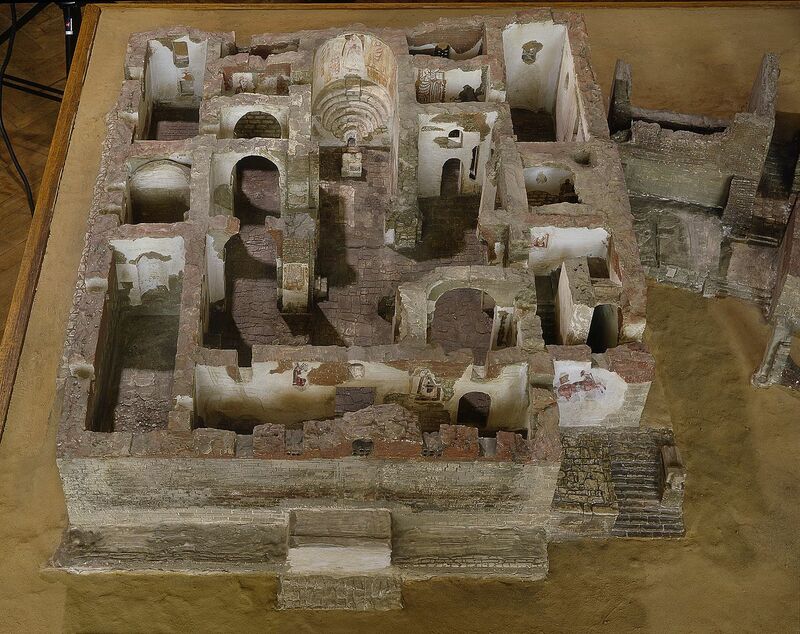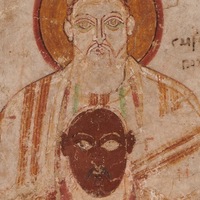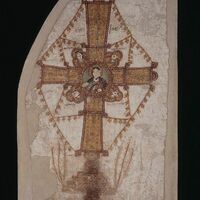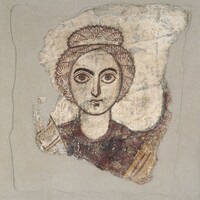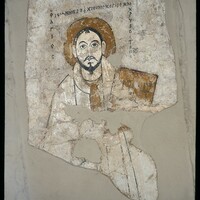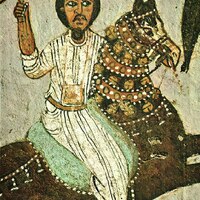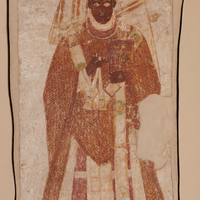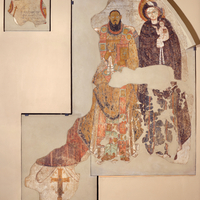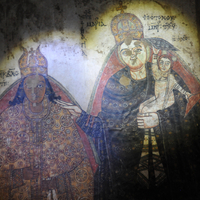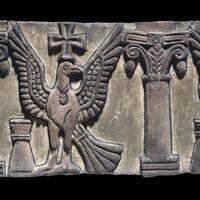Faras Cathedral in Nubia
Type:
Churches,
Wall paintings
Date:
Eighth to fourteenth centuries
Location or Findspot (Modern-Day Country):
Sudan
Medium:
Tempera
Description:
Faras (formerly Pachoras), on the Nile River, was a city in the ancient kingdom of Nobatia in northern Nubia, what is now northern Sudan. The polytheistic Nubians were converted to Miaphysite Christianity by Byzantine missionaries in the mid-sixth century. A cathedral was built at Faras in the seventh century and then rebuilt in stone and baked brick in the early eighth, after Nobatia was absorbed into the Makurian kingdom to the south. The cathedral measured 25 by 23 m. Later renovations to the cathedral included replacing its flat ceilings with barrel vaults and adding a central dome on piers, 13 m tall. The region of Nubia remained Christian for centuries after the Islamic conquest of Egypt, to its north, but after the Nubians converted to Islam in the late Middle Ages, the cathedral filled with sand and was forgotten.
When the Aswan Dam was erected in Egypt in the 1960s, many ancient and medieval sites were submerged in the resulting lake; before that happened, Faras Cathedral was unearthed and six centuries' worth of wall paintings, dating from the eighth to the fourteenth century, were removed. Of those 120 paintings, half are in the National Museum of Sudan, in Khartoum, and the rest are in the National Museum of Warsaw, because Polish archaeologists excavated the church. The paintings were all executed in tempera on mud plaster, with more and brighter colors used in the later paintings. They are related to Ethiopian, Coptic, and Byzantine art but also display distinctively Nubian details of style and iconography. Inscriptions in Greek, Coptic, or Old Nubian identify figures and provide additional information, including an invaluable list of Nubian bishops with their years in office.
Crosses appear in both paintings and relief carvings. The gold, gemmed cross shown here (eleventh century) depicts the four creatures of Ezekiel and Revelation around a bust of Christ. The cross, garlanded with strings of tiny bells, is both the celestial throne and the tree of life, with vegetation growing from its base.
There are numerous images of Christ and Mary; archangels (this one, probably Gabriel, dates to the eighth century); saints (such as John Chrysostom and Anne, both ninth century), and a few narrative scenes: the Three Hebrews in the Fiery Furnace, from the book of Daniel; the Nativity and arrival of the Magi (both late tenth–early eleventh century); and Passion scenes (all the narrative scenes are now in Khartoum). Above the curved synthronon (tiered enches for the clergy) visible in the cathedral model, the apse originally featured Mary flanked by apostles, as in room 6 at Bawit; later a Nubian king was added, and then a bishop. In the north aisle, an image of St. Anne (eighth–ninth century), identified as "mother of the Theotokos," holds a finger to her lips as if bidding viewers to be silent.
Images of the local ecclesiastical authorities in chapels on the cathedral's south side include Bishop Petros (r. 972–99), being protected by his namesake, St. Peter; and Bishop Marianos (r. 1005–36), being blessed by the Virgin and Child. The bishops of Faras were buried just outside the cathedral. Nubian kings and their mothers, who held a very high social status, were also represented. One example is a crowned figure inscribed "Martha mother of the king, may she live many years." She is protected by the Theotokos and Christ child, the former crowned as in the contemporary Nativity scene. In the Faras images, it is the mothers, kings, and bishops who face forward, immobile, while the sacred figures turn toward them—the opposite of Byzantine art. The artists paid close attention to details of garments and insignia, as well as skin tone, differentiating the dark-skinned Petros from the olive-skinned Marianos and Martha and from the saints, all of whom have white skin.
When the Aswan Dam was erected in Egypt in the 1960s, many ancient and medieval sites were submerged in the resulting lake; before that happened, Faras Cathedral was unearthed and six centuries' worth of wall paintings, dating from the eighth to the fourteenth century, were removed. Of those 120 paintings, half are in the National Museum of Sudan, in Khartoum, and the rest are in the National Museum of Warsaw, because Polish archaeologists excavated the church. The paintings were all executed in tempera on mud plaster, with more and brighter colors used in the later paintings. They are related to Ethiopian, Coptic, and Byzantine art but also display distinctively Nubian details of style and iconography. Inscriptions in Greek, Coptic, or Old Nubian identify figures and provide additional information, including an invaluable list of Nubian bishops with their years in office.
Crosses appear in both paintings and relief carvings. The gold, gemmed cross shown here (eleventh century) depicts the four creatures of Ezekiel and Revelation around a bust of Christ. The cross, garlanded with strings of tiny bells, is both the celestial throne and the tree of life, with vegetation growing from its base.
There are numerous images of Christ and Mary; archangels (this one, probably Gabriel, dates to the eighth century); saints (such as John Chrysostom and Anne, both ninth century), and a few narrative scenes: the Three Hebrews in the Fiery Furnace, from the book of Daniel; the Nativity and arrival of the Magi (both late tenth–early eleventh century); and Passion scenes (all the narrative scenes are now in Khartoum). Above the curved synthronon (tiered enches for the clergy) visible in the cathedral model, the apse originally featured Mary flanked by apostles, as in room 6 at Bawit; later a Nubian king was added, and then a bishop. In the north aisle, an image of St. Anne (eighth–ninth century), identified as "mother of the Theotokos," holds a finger to her lips as if bidding viewers to be silent.
Images of the local ecclesiastical authorities in chapels on the cathedral's south side include Bishop Petros (r. 972–99), being protected by his namesake, St. Peter; and Bishop Marianos (r. 1005–36), being blessed by the Virgin and Child. The bishops of Faras were buried just outside the cathedral. Nubian kings and their mothers, who held a very high social status, were also represented. One example is a crowned figure inscribed "Martha mother of the king, may she live many years." She is protected by the Theotokos and Christ child, the former crowned as in the contemporary Nativity scene. In the Faras images, it is the mothers, kings, and bishops who face forward, immobile, while the sacred figures turn toward them—the opposite of Byzantine art. The artists paid close attention to details of garments and insignia, as well as skin tone, differentiating the dark-skinned Petros from the olive-skinned Marianos and Martha and from the saints, all of whom have white skin.
Relevant Textbook Chapter(s):
3,
4,
5,
6
Repository and Online Resources:
• See photos and a video on the website "The Faras Gallery: Treasures from the Flooded Desert."
• Watch a short video here.
• See photos of the excavation and salvation operations on the "Faras 3D: Treasures from the Flooded Desert" website.
Image Credits:
National Museum in Warsaw; Brian McMorrow; Wikimedia Commons
